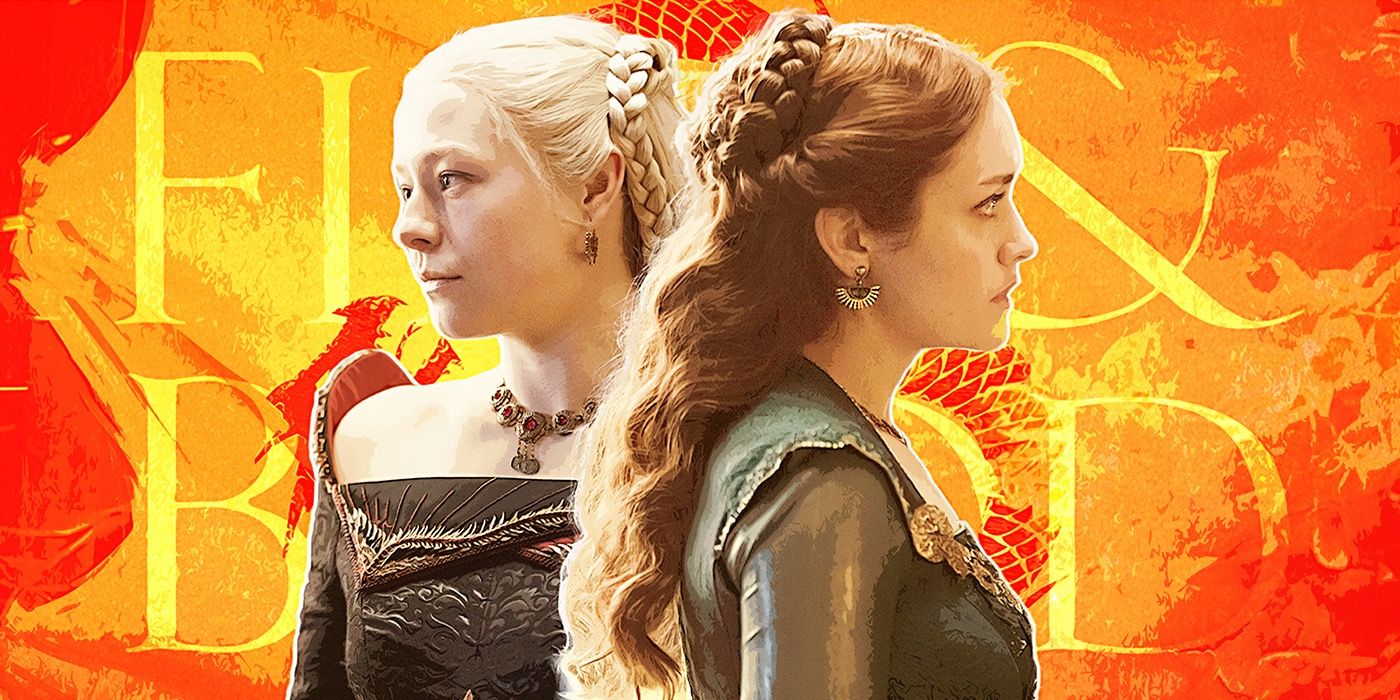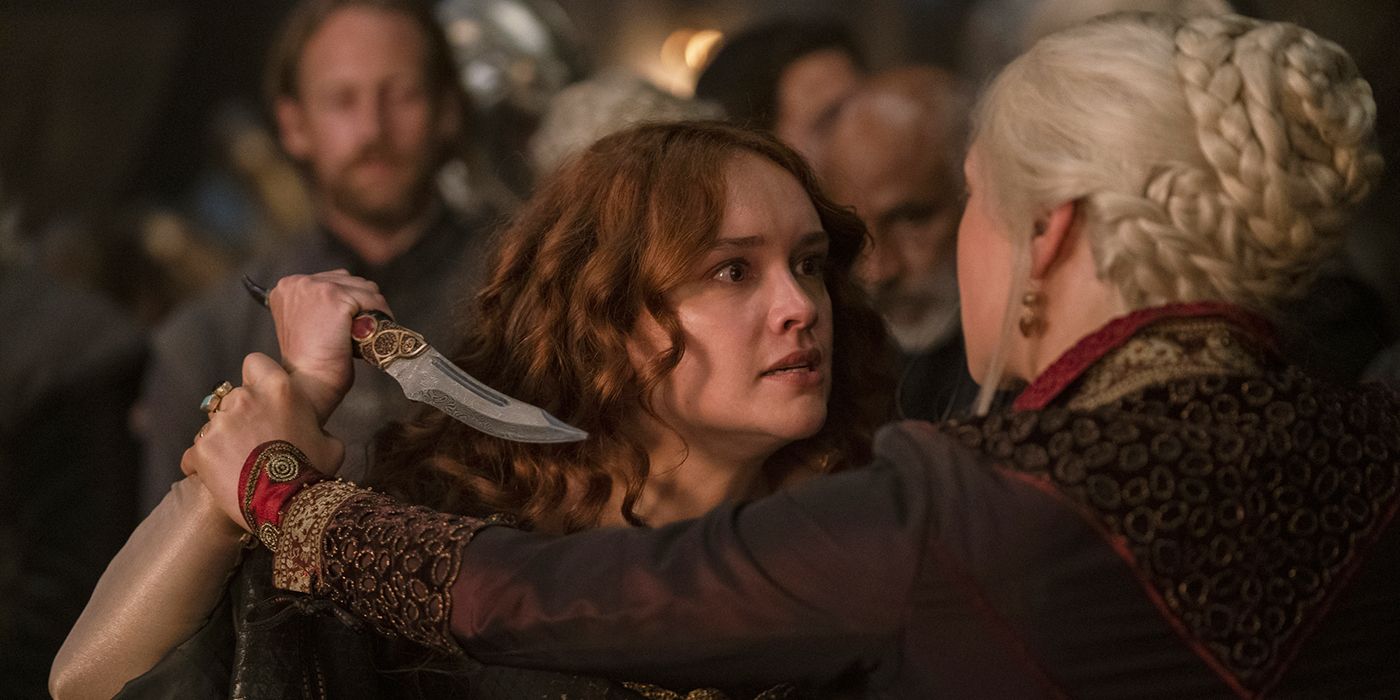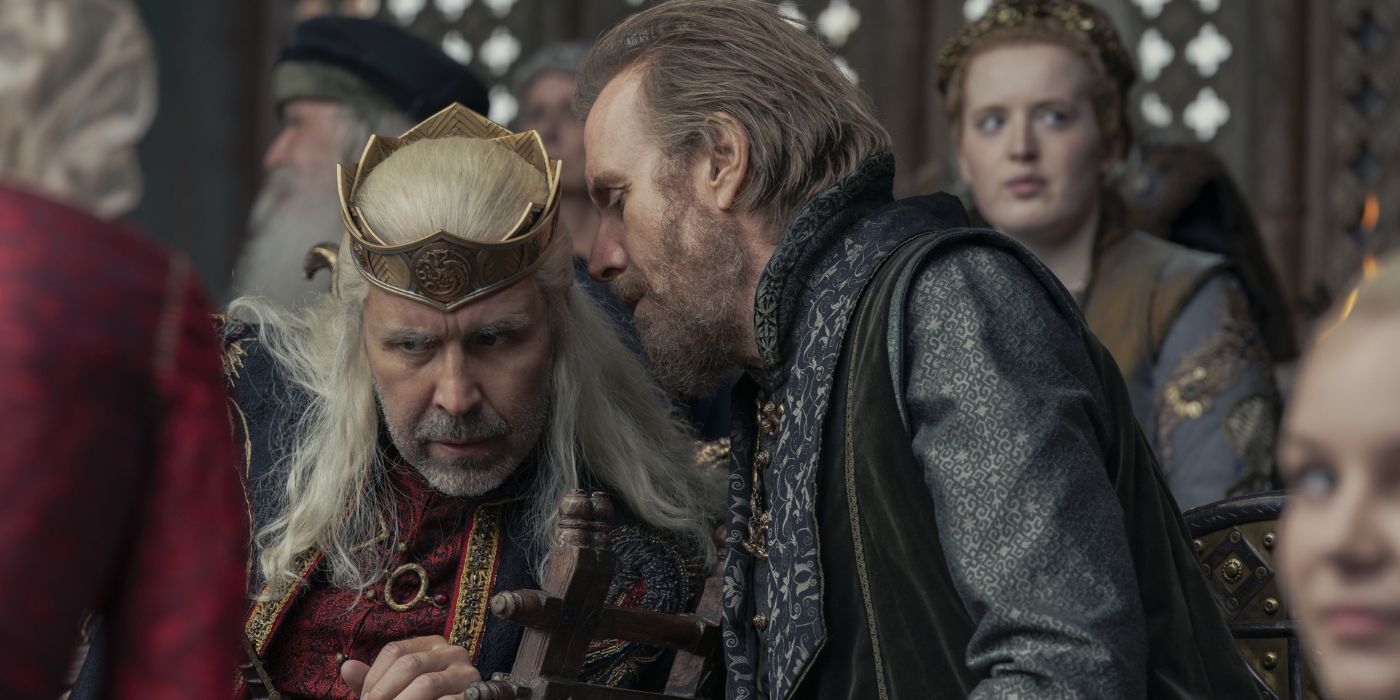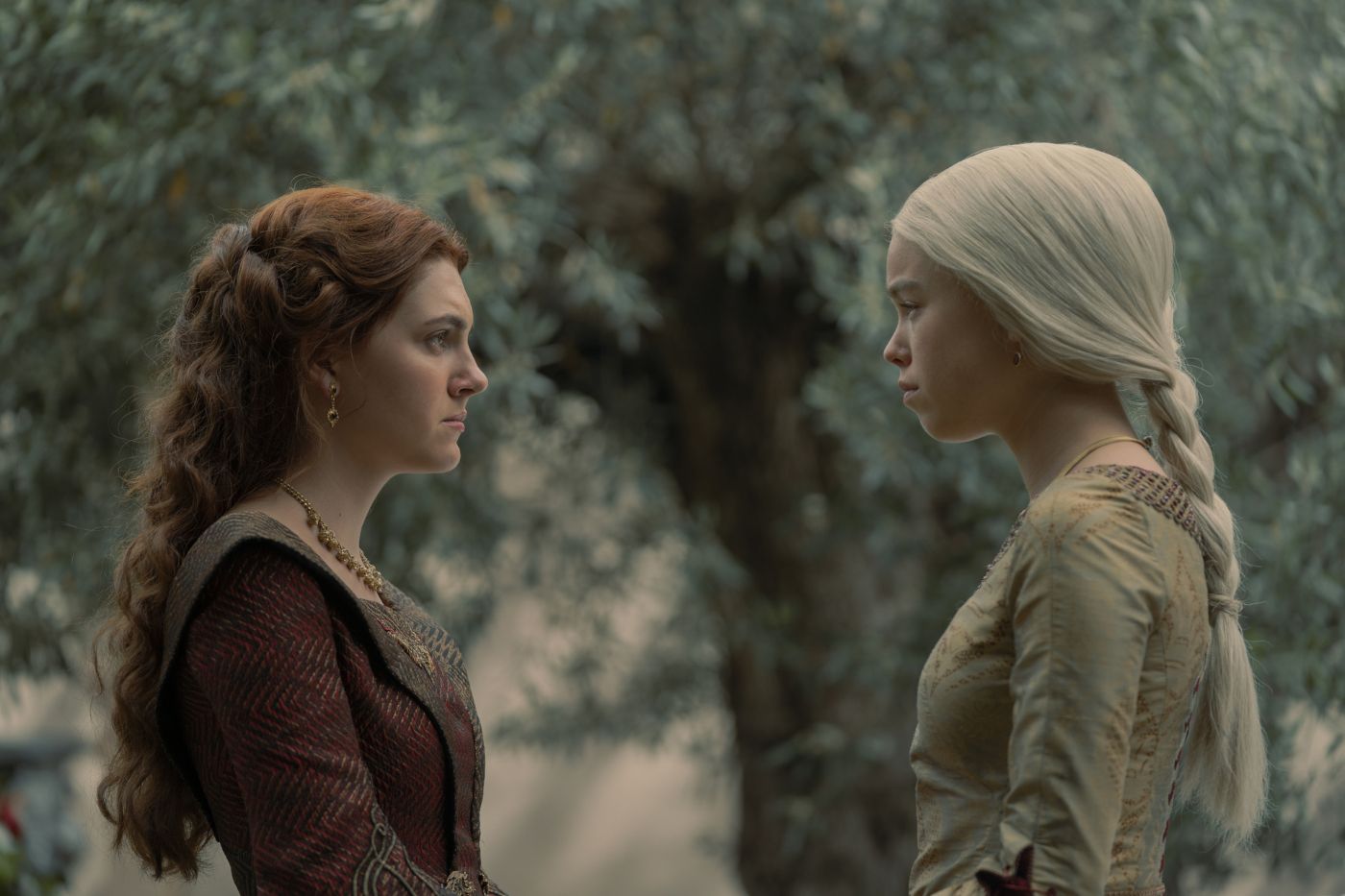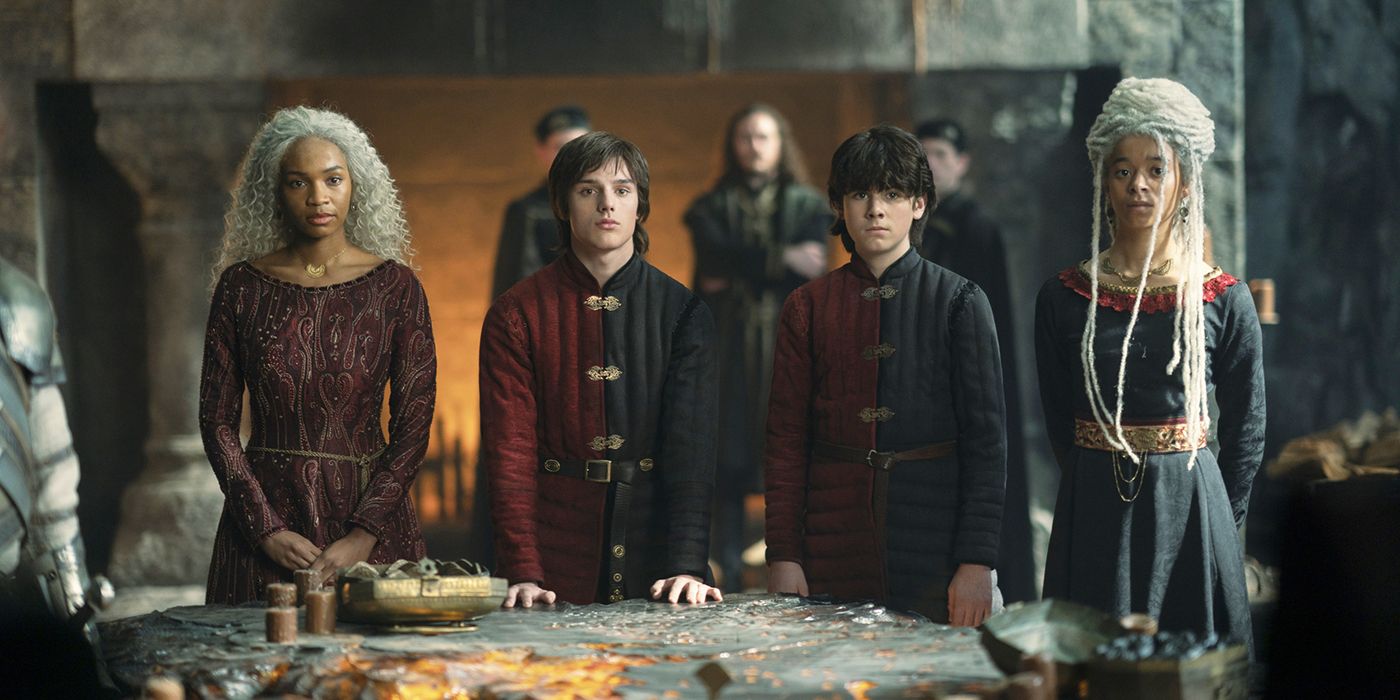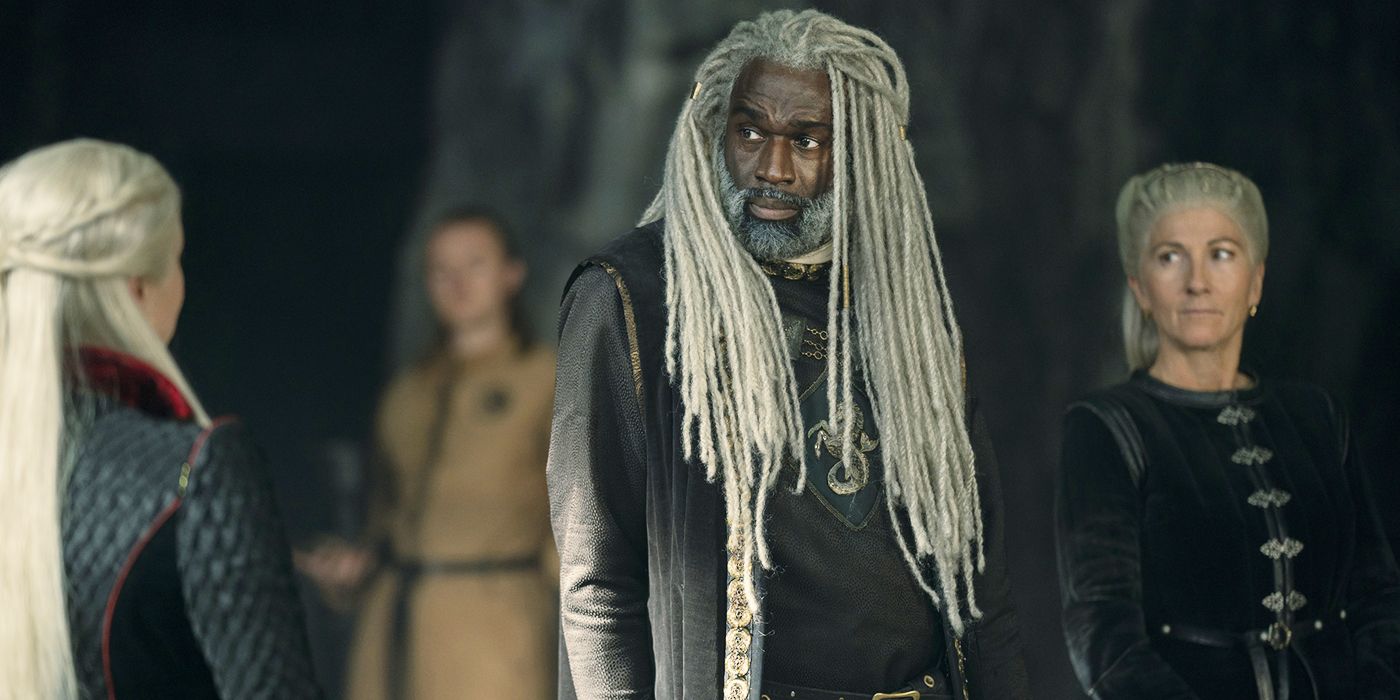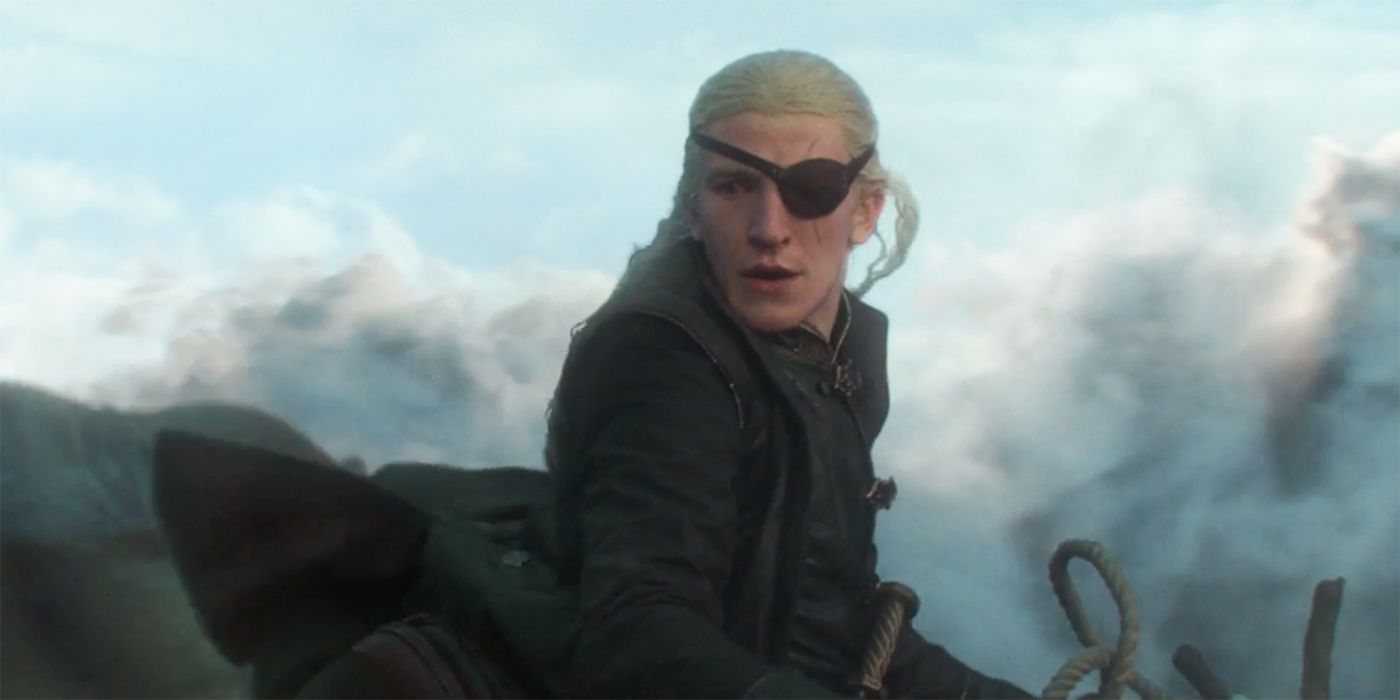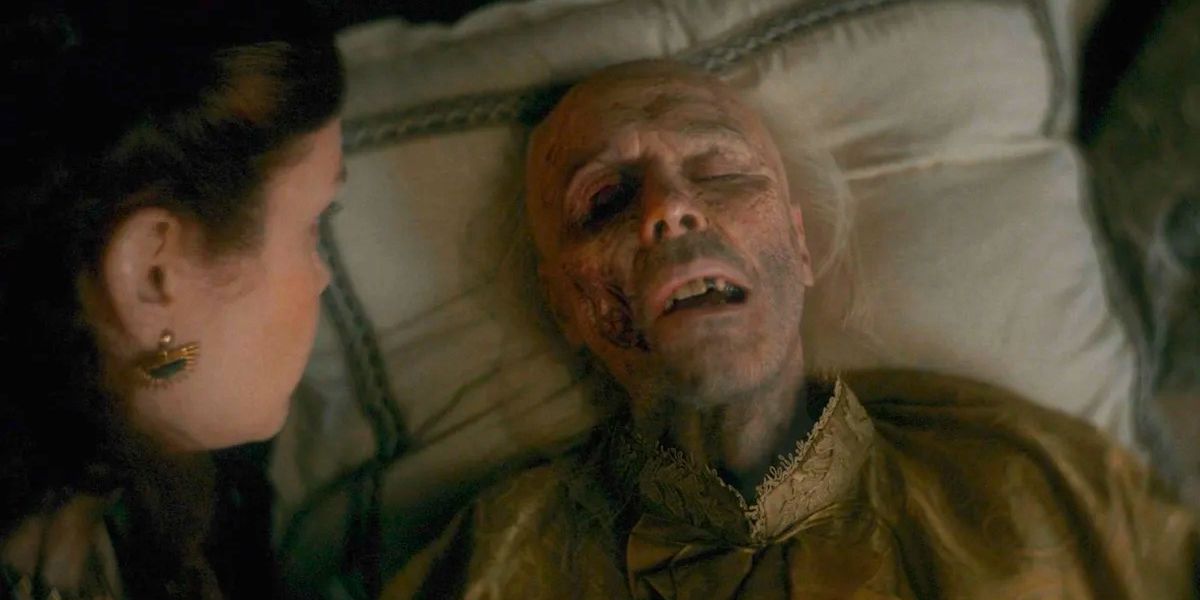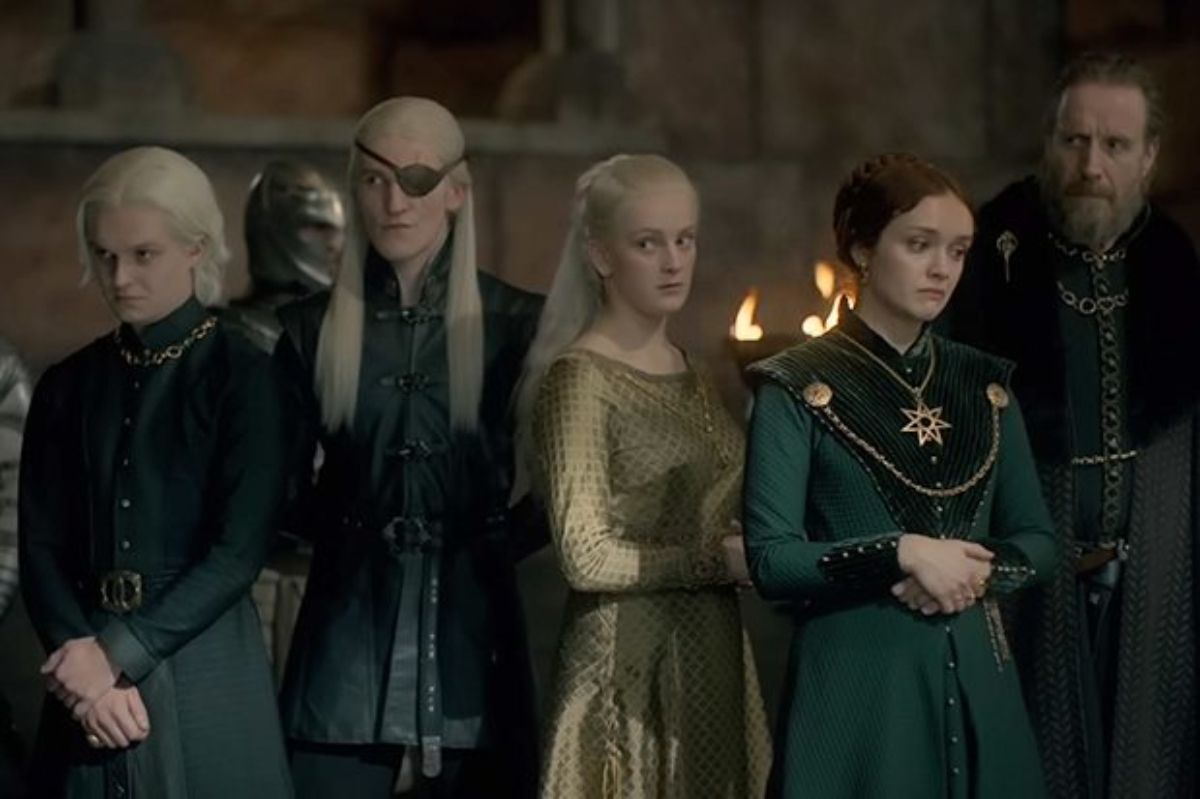Editor's Note: The following contains spoilers for Season 1 of House of the Dragon.Whatever the High Valyrian word is for “escalation,” some maester somewhere must have furiously scribbled it down again and again during this first season of House of the Dragon. In the Season 1 finale of this game of thrones, Rhaenyra Targaryen (Emma D’Arcy) found out that her uncle-husband Daemon (Matt Smith) was never told about the Song of Ice and Fire when he choked her over the news, and Aemond Targaryen (Ewan Mitchell) accidentally killed his nephew Lucerys Velaryon (Elliot Grihault). The two moments were tense, they were exciting – and the former has no source material in Fire & Blood or The World of Ice and Fire, while the latter significantly departed from the page. Season 1 of House of the Dragon has invented many scenes, and even more take George R. R. Martin’s words and spin them around to a degree that the first season of Game of Thrones did not. Those who haven’t read the books House of the Dragon is based on may be curious as to what all’s been changed. Let that curiosity be slaked now.
Subjectivity vs Objectivity
The World of Ice and Fire is a companion book co-written by Martin and Elio M. Garcia Jr and Linda Antonsson, serving as a primer for the known world of the Ice and Fire series. Fire & Blood is an expansion of the material from The World of… concerned with the Targaryen kings of Westeros. Neither is a traditional novel with a story directly experienced through the eyes of any character. Rather, both books are feigned histories, supposedly written by maesters (Maester Yandel for The World of…, Archmaester Gyldayn for Fire & Blood) who themselves draw from in-world sources.
No matter what anyone thinks of House of the Dragon – and this viewer has retained a strong skepticism the past ten weeks, though not so strong he isn't looking forward to Season 2 – it must be appreciated how challenging this material is to adapt. Not only is everything experienced secondhand, but Martin plays with the reliability of the in-world material the maesters had to work with. The rivalry between Rhaenyra and Alicent, and the resulting civil war, is said to be described in The Reign of King Viserys, First of His Name, and the Dance of Dragons That Came After by Septon Eustace; The Dance of the Dragons, A True Telling by Grand Maester Munkin; and The Testimony of Mushroom, an alleged memoir by the witty, ribald, and cynical court jester. These sources frequently disagree on major events, for which no “true” version exists. And that’s leaving out the commentary and bias that Yandel and Gyldayn interject.
During early development, House of the Dragon toyed with incorporating all this subjectivity by having Gyldayn at work, his reading of the various accounts of the Dance of Dragons triggering “reenactments.” That sounds like a fun concept, but it was ultimately abandoned for a more straightforward approach. Co-creator and showrunner Ryan Condal claimed that “We’re taking the approach [of] playing with the history as it was written. Essentially, saying that this is the objective truth that happened.” But the show doesn’t really work as that; it can’t. It’s too often discarded every available version from the source material, rearranged the timing of events, altered character personalities, and left out notable figures (no Mushroom in sight so far) to be the “objective truth” of whatever went on within Martin’s pages. It’s a new version all on its own.
Changes at the King’s Court
One of the biggest changes House of the Dragon made, so far as setting and tone goes, concerns the atmosphere within the Red Keep. The court of King Viserys (Paddy Considine) is as tense and uncomfortable a place as Robert Baratheon’s was in Game of Thrones. There are military threats, dangerous rivalries among members of the Small Council, and everyone’s fretting over the succession. Viserys himself is gaunt, sickly, and not much of a king. He’s not much of a father or a husband either; his relationships with Rhaenyra and Alicent are both awkward. If he’s good for anything, it’s assembling miniatures in his room and keeping alive the Targaryen knowledge that, one day, they must confront the doom of men from the Land Beyond the Wall. Over this unhappy court, the clouds of war can only make a grim scene grimmer.
The three chroniclers quoted from in Fire & Blood focus on the gathering of those clouds, but they all suggest that tension grew behind the scenes of an outwardly glorious court. Viserys is said to reign over the height of Targaryen power. Feasts and frolics were aplenty, lords and smallfolk were well-pleased, and Viserys was a plump, jolly fellow who delighted in his daughter, loved his wife, and kept the peace between them as long as he was alive. While still flawed as a ruler and a family patriarch, he arguably had more mettle and complexity to him as a party-loving peacekeeper than a haunted prophet, a trait cribbed from a later Targaryen king. And while he did suffer health problems later in life, he never became half a corpse, gasping for air and desperately clinging on in the hope of putting his family to rights. A haunted king who dies in a retched state isn't much of a contrast with the tragedy and misery around him, but Considine's performance has been invariably excellent.
Blacks vs. Greens
It's not just Viserys whose nature is changed. Rhaenyra, nicknamed the Realm’s Delight, is precocious, popular, and overindulged in the book, possessed of charm and a long memory for slights. She and her father are not at constant loggerheads over how her behavior affects politics, and her succession is only ever jeopardized when she tries to avoid marrying Laenor Velaryon (John Macmillan), a match the show had her personally and diplomatically negotiate with her betrothed. Alicent Hightower, who first came to court to help care for the Old King, Jaehaerys, is much less a meek servant of duty in the book and a more active schemer from the start. She’s significantly older than Rhaenyra, and the two were not childhood friends.
In making them so, House of the Dragon has injected a layer of tragedy and personal history into the conflict between Rhaenyra and Alicent. On the other hand, instead of a gradually building, mutual animosity, Alicent seems to turn on a dime against Rhaenyra once she learns about her sexual dalliances. Not only is their friendship broken, but Alicent becomes recalcitrant, paranoid, and embittered over Rhaenyra’s youthful flouting of decorum. One might find that too big a leap in too short a span of screen time. One might also argue that, in going so far as to attack the heir apparent in Episode 7, Alicent harmed the succession in worse ways than Viserys’s brother Daemon ever did, and it strains credulity that Viserys took no action.
And one might argue that, in having her misinterpret Viserys's final words and play no part in her father Otto's (Rhys Ifans) pre-death scheming, the show denied Alicent agency - and culpability - in the wars to come. But the show has at least been consistent in making her more guided than a guide. Rhaenyra's attitude toward the Iron Throne has also been altered. There's not much sign of her book counterpart's hot temper or preoccupation with her rights. The adult Rhaneyra of the show has looked more to her duty, if not to the realm than to the prophesied Song of Ice and Fire, so much so that she was willing to entertain terms if it meant peace and unity ahead of the darkness from beyond the North.
Besides characters, details of time and place were played with throughout Season 1. When and why Daemon leaves or returns to court; when and where the black and green dresses are first worn; when Criston Cole (Fabien Frankel) changes his color; and so on. The stand-off at Dragonstone over an egg is invented, Mysaria was pregnant on the page, Daemon gave up his crown at a tourney, and Joffrey Lonmouth (Solly McLeod) died at one too, not a wedding. None of these are so fundamental as changes to character personalities, so how big a deal they are depends on how much fidelity to detail and minutia a book reader desires from the show.
House Velaryon
From King's Landing to Driftmark, changes abound. In the books, Corlys Velaryon (Steve Toussaint) is known as the Sea Snake, for the ship in which he made nine legendary voyages. From his youngest days, he took to sailing like a fish to water. It’s odd to hear a character so in love with the sea complain bitterly to Daemon Targaryen about House Velaryon having to “scratch out a living” through trade and seamanship. And it’s odd to see him running around in a suit of armor during battle instead of commanding from a ship. Yet those are the choices the show made in adapting Corlys and Daemon’s war in the Stepstones.
On the page and the screen, Corlys is an ambitious man who takes his house’s repeated rejections poorly. But he doesn’t resign from the Small Council when Viserys passes over his daughter, because he already resigned after the Great Council elected Viserys king. And he doesn’t mix his quest for legacy with outrage on behalf of his wife Rhaenys (Eve Best), because Rhaenys was never a serious contender for the Iron Throne at the Great Council. It was their son, Laenor, who was considered for kingship. While the show made Rhaenys the contender of that branch of the family, it's taken its time in showing her pride, hot temper, and her own considerable efforts alongside her husband’s to advance their bloodline.
At first, it was just the opposite; the show’s Rhaenys seems content to abandon ambition for safety, for herself and her children and grandchildren. By Episode 9, of course, she smashes through the floor of the Dragonpit, something she wasn't present to do in the book. And in the tradition of Peter Jackson's adaptation of The Lord of the Rings, House of the Dragon invented a reversal for Episode 10 not present in the source: in the season finale, Corlys is suddenly prepared to abandon ambition and live in peace, while Rhaenys embraces Rhaenyra's claim to the Iron Throne. One might argue that, just like many of Jackson's reversals in Rings, this was a rather arbitrary and contrived switch of positions just to get some extra drama into a single scene. But it passes quickly, and it amounts to the same decision as in the books: House Velaryon stands with the Blacks.
Some finer details are reworked with the Velaryons too. To go strictly by the books, Laena (Nanna Blondell) and Daemon should end up back at Driftmark after their marriage, receiving regular friendly visits from Rhaenyra, and Laenor should live apart from Rhaenyra most of the time. But the change that’s most animated the Internet is the Velaryons’ race. They are meant to be of old Valyrian blood, just like the Targaryens, with the families intermarrying several times even before Aegon the Conqueror won the Seven Kingdoms.
While racist trolls will seize any excuse to be awful, the casting of the Velaryons is a departure from the books, and one Garcia Jr. and Antonsson (who have no involvement with House of the Dragon) found hard to reconcile with the kinship of the houses and the occult obsessions of the Valyrians. They suggested Cole, the Hightowers, or residents of the trade city of Oldtown as other opportunities to introduce greater diversity to Westeros. But Condal and co-showrunner Miguel Sapochnik made their choice based on an early concept of Martin’s, and Garcia Jr paid high compliments to Toussaint’s work as Corlys. Incidentally, Rhaenys is meant to be a rare Targaryen without silver hair; her mother being a Baratheon, she inherited the raven locks of that house in the books.
Who Died, and How?
As of Episode 9, six major deaths have been significantly altered from Fire & Blood. The first is Aemma Arryn's. While Viserys’s first wife struggles with miscarriages and dies in childbirth in both versions, the book’s Aemma dies only from complications. Viserys’s hard choice between definitely losing both or sacrificing Aemma to chance saving the baby is taken from an earlier incident in Fire & Blood. There, Jaehaerys’s pregnant mother Alyssa Velaryon is doomed either way, but her child by Rogar Baratheon could be saved. At least one source tells Gyldayn that she was informed and consented to the plan – something Viserys never does for Aemma.
The second significantly altered death is Laena Velaryon's. Again, the cause of death is the same: childbirth. But Martin’s Laena delivers a malformed child who soon dies while on Driftmark. She lingers on for three days, reportedly trying and failing to take a last ride on her dragon Vhagar. Daemon and Rhaenyra keep a vigil over her until the end. House of the Dragon moves the birth to Pentos and creates a parallel between Laena and Aemma’s deaths, with Daemon presented with the same choice as Viserys and deciding not to sacrifice his wife. Laena then makes her way to Vhagar and orders herself burned alive.
Third is the death of Laenor Velaryon, and for once the show gave a character a reprieve compared to his book counterpart. Laenor very explicitly dies at the hands of Ser Qarl Correy in a public street in Fire & Blood, possibly on the orders of Daemon Targaryen without Rhaenyra's involvement. In House of the Dragon, Daemon is explicitly behind a plot to get Laenor out of the way – but it’s a plan made with Rhaenyra and Laenor’s and compliance. Leanor stages his own death with Correy and flees across the Narrow Sea.
Fourth is the death of Viserys, First of His Name, whom Martin allowed to die peacefully during a nap. TV's Viserys dies less peacefully in his sickbed, but the big change comes when he spends his last words muttering snatches of the Song of Ice and Fire - which Alicent alone overhears. Not knowing of the Targaryen prophecy, she takes Viserys's jumbled words as his express wish to name his son Aegon (Tom Glynn-Carney) heir. It's apparently an honest mistake, albeit one she probably could have realized with a bit of thought.
Fifth is the death of Rhaenyra's third child by Daemon. The death of the babe itself isn't much different from the book, though The World of... and Fire & Blood both confirm that the child was a girl, Visenya, and that she was one of several Targaryen stillborns with dragon-like deformities. It's Rhaenyra's reaction that is changed. The only chronicler to be present for Visenya's birth is the jester Mushroom, one of the more unreliable narrators the maesters rely on, but he claims that Rhaenyra - a far more temperamental character in the books - is ready for war as soon as Visenya dies. "She was my only daughter," the queen says, "and they killed her. They stole my crown and murdered my daughter, and they shall answer for it."
Last is the murder of Luke Velaryon. As with Visenya, the death itself is largely unchanged: Luke dies while fleeing on dragonback from his uncle Aemond. But while none of the chroniclers or maesters of the books were present for the dragon battle, their accounts of the lead-up and aftermath very strongly indicate that it was no accident. The show's choice to have both dragons disobey their riders, culminating in Luke's death to Aemond's apparent horror, is pure invention.
The Coming Dance
Rhaenyra and Alicent's children are loosely sketched in Fire & Blood, but the sketch suggests that Team Black's second generation was far worthier to rule. Jace (Harry Collett) was responsible and honorable and Luke (Elliot Grihault) was faithful. On Team Green's side, Aegon was a gluttonous and lustful sloth and Aemond (Ewan Mitchell) a bully. Now that the kids are more or less grown, the show has more or less committed to these personalities, though it drifted a bit in having Aemond be the put-upon brother. And while at least one source has Aegon reluctant to usurp his half-sister's crown in Fire & Blood, the abject misery at the thought of ruling and the insecurity shown by Glynn-Carney aren't present, nor is Aemond's own desire for the throne. With the Dance of Dragons itself now begun, it remains to be seen in Season 2 and beyond how much further their stories will diverge from what Martin indicated.

